Source: Buffalo Field Campaign
“Here at SFTHH we have care and concern for all things wild as we would like to see our fellow passengers, on this Spaceship Earth, keep their rightful seats as being…WILD and FREE!” ~ R.T.
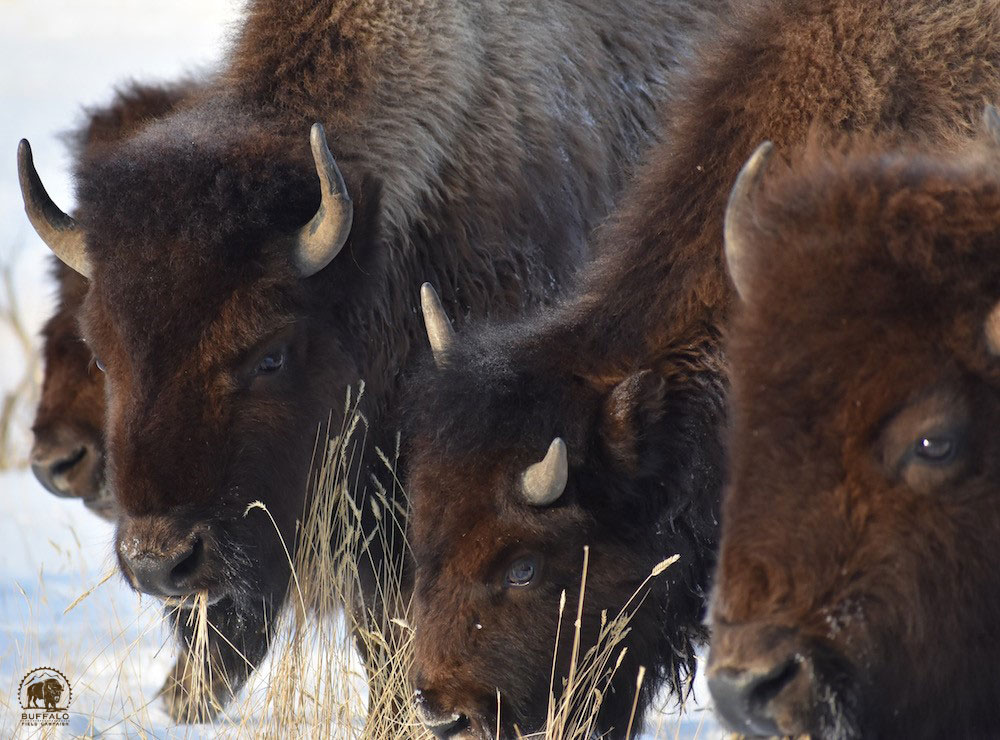
Our beautiful friends and relatives, the buffalo, moving into the Gardiner Basin. Photo by Stephany Seay, Buffalo Field Campaign.
We haven’t had too much to report from the field yet this season, but that has now changed. After months of inactivity due to a relatively mild winter, our last snow event triggered wild buffalo migration, bringing them out of deeper snows in Yellowstone’s higher elevation habitat, to easier grazing in the Gardiner Basin. Our Gardiner camp is now open and in full swing. Gardiner patrols are a full week long, and consist of two to four volunteers doing both morning and afternoon shifts, monitoring the huge expanse of one of North America’s largest wildlife migration corridors. Gardiner is rich with herds of elk, mule deer, bighorn sheep, pronghorn antelope, as well as wolves, coyotes, eagles, and other amazing wildlife. Now, hundreds of wild, migratory buffalo have made their way into the Gardiner Basin, and while we are so thrilled once again to be in their presence after such a long absence, they are being met with all kinds of challenges.
We hope it goes without saying, but let it be said that BFC sincerely appreciates, respects, supports, and honors treaty rights and Tribal participation with the buffalo, and we know we have to come together — being naturally the strongest allies for the buffalo — to combat the real culprit, which is the State of Montana and the Interagency Bison Management Plan, who continue to try and divide us as they attempt to prevent these sacred beings from restoring themselves on their native habitat.
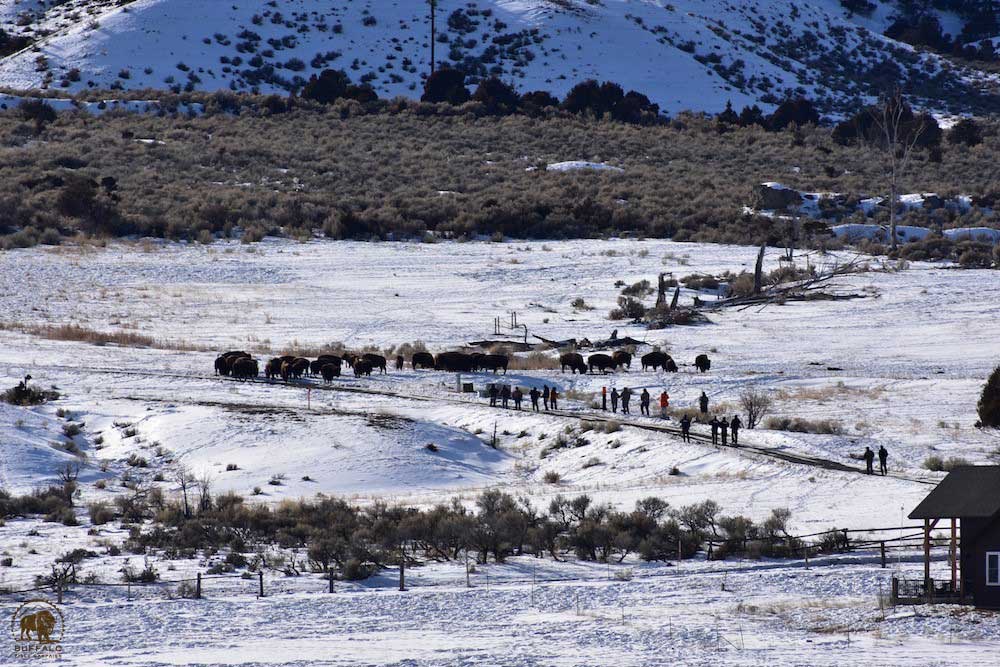
Beattie Gulch. A hunting landscape that is a recipe for disaster. The buffalo population must be allowed to flourish, and spread out on a much larger landscape. Photo by Stephany Seay, Buffalo Field Campaign.
Hunting has begun in earnest in Gardiner, mostly within the infamous “killing box” of Beattie Gulch, a very narrow migration corridor, used mainly by matriarch-lead family groups, which takes them out of the relative shelter of Yellowstone National Park into areas where they can be taken by hunters. We say “relative shelter” because just a mile south of Beattie Gulch, inside the Park, is Yellowstone’s nefarious Stephens Creek buffalo trap. As of this writing, forty buffalo have been taken by hunters, thirty-five of these have been killed since Sunday. Hunters have waited months for migration to begin, and now that it has, they are wasting no time trying to fill their tags.
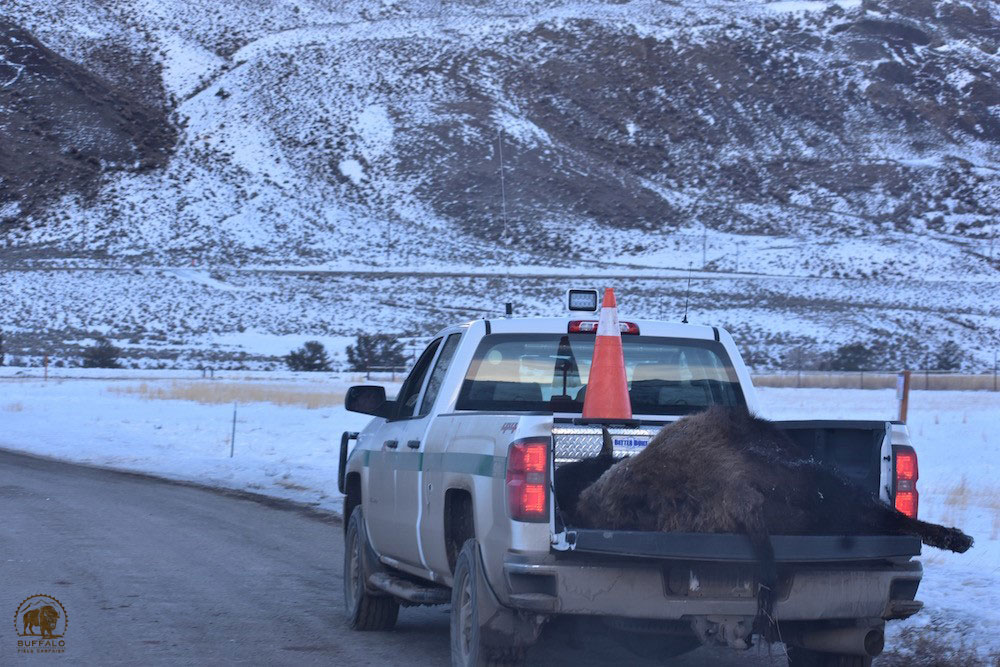
An unnecessary casualty of a hunt on a landscape that is much too small, of a population that must be allowed to grow and restore themselves. Photo by Stephany Seay, Buffalo Field Campaign.
On Sunday, hunters took 19 buffalo — taking an entire family group of 15, then later another four — then on Monday, another nine were taken, and on Tuesday ten more. Tuesday’s event was especially tragic because multiple hunters approached a small herd, firing into them eager to fill their tags: consequently, in addition to the ten who were killed on the spot, five other buffalo were shot, injured, and fled into the Park. Of these five, two died inside the Park, one more had to be put out of her misery by a Park Ranger, and the two others who were hit had relatively minor injuries so are still walking around, though wounded. Buffalo are very tough animals, and it is amazing what they are able to survive, though it pains us greatly to know they have been injured in such a way. While each individual is responsible for their actions, it is critical to point out that this hunt and the minimal landscape it is carried out upon, has been set up by the State of Montana and other bison management agencies to result in exactly the things we continue to see taking place year after year. The hunt as it now is, is being used to prevent wild buffalo from restoring themselves on their native habitat. Buffalo are granted very little habitat outside Yellowstone’s boundaries, and the landscape they are able to access is a patchwork of both public and private land, where hunting rules and opportunities are very different. This sets both hunters and buffalo up for unnecessary failure, a disaster crafted by Montana and the Interagency Bison Management Plan. Hunters are driven into competition with each other, and also are pressured into feeling a race against Yellowstone’s buffalo trap. All of this happening to a buffalo population — the last of its kind — that can not sustain such hunting pressure, and certainly not capture for slaughter. There is a simple solution which Montana will soon have to embrace: many more buffalo on a much larger landscape; respect wild buffalo like wild elk in Montana: let them roam!
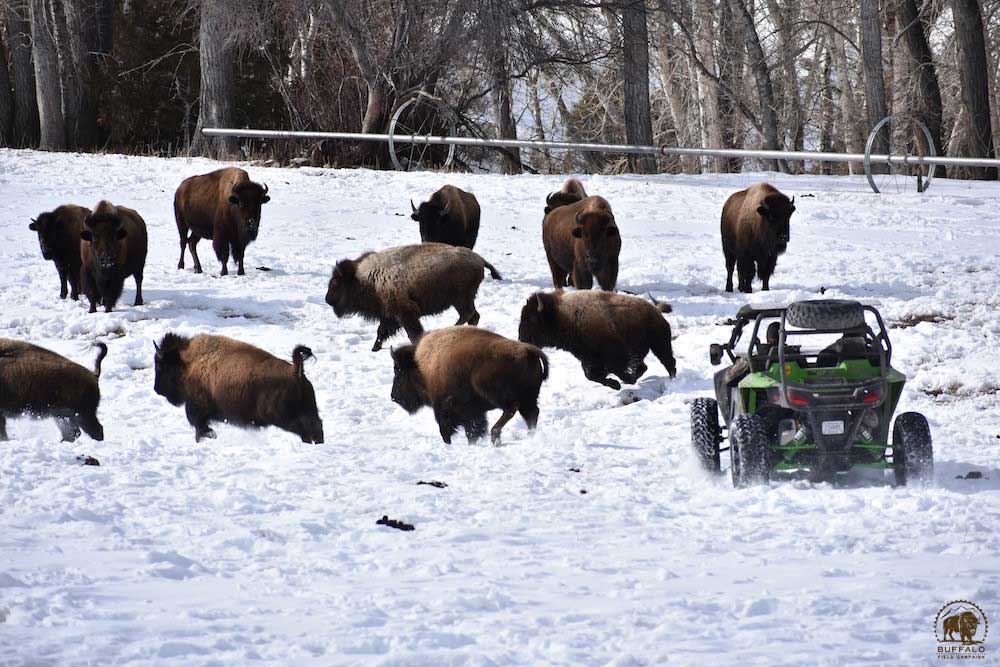
A very aggressive hazing operation conducted by two intolerant locals. Across the river, hunters waited to the north, while Yellowstone’s trap gets prepared to the south. Photo by Stephany Seay, Buffalo Field Campaign.
We also witnessed an event we haven’t experienced in many years in Gardiner: a hazing operation. But, this one was conducted by a couple of private citizens, rather than government agencies. There were about 40-200 buffalo spending peaceful time grazing on a private pasture, which is under conservation easement. There is also a very small band of horses and mules who use this pasture, and the buffalo and equines were getting along just fine. But, apparently a couple locals didn’t like it. As we were monitoring the Beattie Gulch area, we were parked right by this pasture with the buffalo, and suddenly a dune-type buggy races into the snowy field and proceeds to very aggressively haze the gentle giants off of the pasture, across the Yellowstone River, and into Yellowstone National Park, where they started heading towards Beattie Gulch. As this was happening, a smaller group of buffalo were moving into Beattie Gulch where hunters waited for them. That’s when the fifteen buffalo mentioned above were shot. As the survivors of this group bolted back into Yellowstone, they met up with the 200, who did an about face and joined them moving further into Yellowstone.
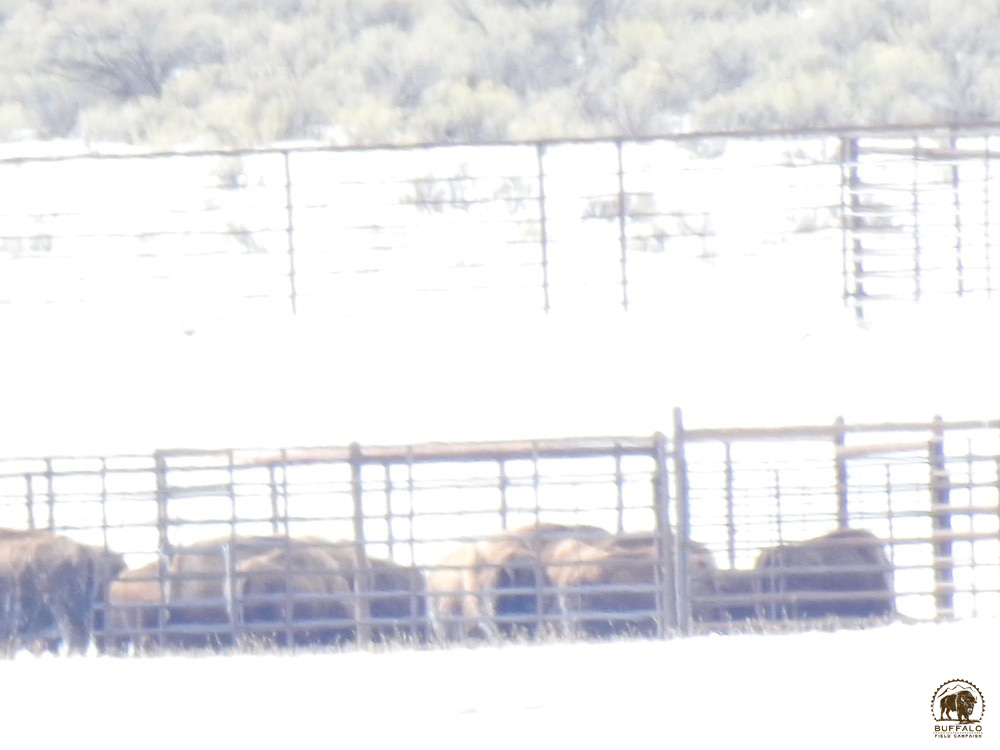
Buffalo clearly within the fence line of Yellowstone’s Stephens Creek buffalo trap. Yellowstone states they have not yet begun capture operations. We are monitoring the situation very closely, and we will have better photos for you soon — we were trying out a new camera with a strong zoom lens. Photo by Greg Marin, Buffalo Field Campaign.
The following morning, Wednesday, there were about 250 buffalo scattered between the area around Yellowstone’s Stephens Creek trap and lands just south of Beattie Gulch. Many hunters were waiting at Beattie Gulch for the buffalo to approach, which we were certain they would do as well. There was one young female who seemed to be in a real hurry to get to Beattie Gulch, but the others moved slowly. The little girl kept looking back, waiting, but the other stopped to graze. She stood out for a long time, seemingly pleading and impatient. Why did she want to go to Beattie Gulch so badly? Had she lost a relative there the day before? Did she know something else? Reluctantly, she rejoined the herd. Then, as the morning went on, something strange happened. These buffalo who were closest to Beattie Gulch crossed the Yellowstone River and came back on to the pasture they had been hazed from the day before. They were there for just a short while, when all kinds of law enforcement, plus a local outfitter, showed up and were watching them. Two small spotter planes were also seen flying around this area. Out of nowhere something spooked the buffalo or triggered them into a bit of a stampede. Seemingly for no reason, they bolted off the pasture, swam across the river, back into the Park, danced around for a while, then started making a bee-line towards the trap. That same young female tried coaxing them in the opposite direction, towards Beattie Gulch. Again, her pleading fell on deaf ears. Not long after, we witnessed many of the buffalo in this area heading straight for the open gate of the trap’s outer catch pen. In they went, one after another as caught in a spell. Were they being baited into the trap? Did that little buffalo know this was about to happen? Why did they suddenly head there? Have federal and state agencies expanded on the methods used to snare wild bison? It was interesting to see those buffalo abruptly change course and walk straight toward the Stephen’s Creek Trap. Seen feeding near the outer gates, then moving inside with purpose, the buffalo seemed to be attracted by something located there. Responding to our inquiries about capture this morning, Yellowstone officials reached out denying any current activity to corral bison, though we have documentation of them inside the trap’s fence line. We are monitoring the situation very closely, and make no mistake, whether it begins today or next week, Yellowstone certainly intends to capture (for slaughter and domestication) hundreds of the country’s last wild, migratory buffalo — a sacred, keystone species who warrants federal protection, not persecution.
TAKE ACTION!
Please contact:
Yellowstone Superintendent Cameron (Cam) Sholly
Yellowstone National Park
P.O. Box 168
Yellowstone National Park, WY 82190-0168
Phone: (307) 344-2002
Email: Yell_Superintendent@nps.gov
WILD IS THE WAY ~ ROAM FREE!
Categories: The Force of the Horse, Uncategorized









This breaks my heart – reading about the same crap being done to these animals – who deserve a life – as is being done to our wild horses. The eagerness to “make a kill” – slaughtering a whole family of buffalo? Taking their lives away? This is NOT hunting in any shape or form – this is slaughter! Every wild species at this point is being either hunted down or just pushed out.
LikeLiked by 1 person
PEOPLE – MAKE THE PHONE CALL & PROTEST THIS MASSACRE TO THOSE IN CHARGE OF IT. I just did. The “hunters” are mowing down entire families as they migrate thru the pass. Just unbelievable. Compares to shooting people as they come thru the gates at a concert. Sick. All of it.
LikeLiked by 1 person
When laws are made to protect the guilty or are ignored there is sometimes no other recourse
Twenty-one year old Buffalo Field Campaign volunteer Comfrey Jacobs sacrificed his freedom to free wild buffalo. On March 6, 2014, Comfrey took individual and direct action and blocked access to Yellowstone’s Stephens Creek buffalo trap, in an attempt to prevent more wild buffalo from being shipped to slaughter. This is BFC’s exclusive footage and interview with this brave man.
LikeLiked by 1 person
PEACE IN THE VALLEY (a few excerpts)
.BY TODD WILKINSON
Less than 150 years ago, the species was on the brink of elimination and today, at least 4,500 bison inhabit our first national park. However, more could be done to protect the animals outside of park boundaries in Montana
There is an overall attitude of social acceptance for bison in Jackson Hole. We have a benign respect,” Dr. Franz Camenzind says. “What it basically comes down to is that we like having them around, we like seeing them. They are icons of the West and their presence confirms the reason we live here. It’s not the melodrama you see in Montana.
”“I think there are lessons to be learned in the Tetons,” said Dan Wenk, the former superintendent of Yellowstone who retired in October 2018 following a distinguished 43-year career with the National Park Service. Wenk was devoted to finding a way for Yellowstone bison to have more latitude outside of the park but faced stiff resistance from Montana livestock interests.
It was Wenk’s advocacy for using Yellowstone bison as seedstock for other herds that, some say, led to Interior Secretary Ryan Zinke acting to remove him from Yellowstone.
Wenk’s successor in the job, Cam Sholly, is picking up where Wenk left off, aspiring to resolve a vexing, contentious controversy that has raged for two human generations. After that, the disease does not affect reproduction, but it can mean trade restrictions for infected cattle herds.The longstanding rationale invoked by Montana officials for slaughtering Yellowstone bison is that they pose a danger to domestic cattle herds. However, a recent benchmark report from the National Academies of Sciences notes there has never been a case of wild bison passing brucellosis to beef cows
Eric Cole, who today is a senior biologist at the National Elk Refuge, has watched Jackson Hole’s relationship with bison mature. “What a rare situation it is that we have one of the largest free-ranging bison herds in North America and it’s remarkable that it happens in close proximity to so many people,”
Cole said.He shared another observation that he knows might not play well with many elk hunters: “Personally, based on my observations, bison just seem to have more going on mentally and socially than elk do. Their interactions with each other are more complex and they are curious about what people are doing.
Jackson Hole ranchers know they share the neighborhood with publicly beloved wildlife, rancher Brad Mead—the brother of former Wyoming Gov. Matt Mead—told me years ago. As part of that responsibility, they vaccinate their cattle against disease and accept the likelihood that wildlife may co-mingle with beef cows and horses.
One of the main culprits behind lack of tolerance for bison in Montana is a document called the Interagency Bison Management Plan, which was ratified in 2000 and has been assailed as antiquated in the face of more scientific knowledge.
One former Yellowstone superintendent, Mike Finley, said the Park Service was forced to abide by its terms by the state of Montana and the federal Animal Plant and Health Inspection Service that created an exaggerated fear about disease risk.
http://www.mtoutlaw.com/peace-in-the-valleys/
LikeLike
PEACE IN THE VALLEY (a few excerpts)
.BY TODD WILKINSON
Less than 150 years ago, the species was on the brink of elimination and today, at least 4,500 bison inhabit our first national park. However, more could be done to protect the animals outside of park boundaries in Montana
The longstanding rationale invoked by Montana officials for slaughtering Yellowstone bison is that they pose a danger to domestic cattle herds. However, a recent benchmark report from the National Academies of Sciences notes there has never been a case of wild bison passing brucellosis to beef cows
There is an overall attitude of social acceptance for bison in Jackson Hole. We have a benign respect,” Dr. Franz Camenzind says. “What it basically comes down to is that we like having them around, we like seeing them. They are icons of the West and their presence confirms the reason we live here. It’s not the melodrama you see in Montana.
”“I think there are lessons to be learned in the Tetons,” said Dan Wenk, the former superintendent of Yellowstone who retired in October 2018 following a distinguished 43-year career with the National Park Service.
Wenk was devoted to finding a way for Yellowstone bison to have more latitude outside of the park but faced stiff resistance from Montana livestock interests
http://www.mtoutlaw.com/peace-in-the-valleys
LikeLiked by 1 person
Has anyone actually gotten to talk to a REAL person when calling the park superintendent’s office?
Just leaving a message is not enough.
We need some honest to goodness communication and those in charge need to be accessible to the public
LikeLiked by 1 person
YELLOWSTONE
‘The Killing Fields’: Bison come to roam. Then they die
Rob Hotakainen, E&E News reporter
“”It’s just a matter of time before someone is killed it’s not if, it’s when,” said Bonnie Lynn, Oliver’s next-door neighbor. “We need the truth out.”
In the summertime, Sue Oliver can peer out her dining room window to see the majesty of snow-covered Electric Peak just across the bumpy gravel road in front of her retirement home along the Yellowstone River.
In the winter, when the hunters come, she’d just as soon close the curtains to avoid a different scene: the routine slaughtering of hundreds of bison. It happens each year at Beattie Gulch, a narrow strip of unoccupied federal land next to the park’s northern border, just a stone’s throw from Oliver’s house.
“It’s one of those things you can’t believe until you actually see it,” said Oliver, 63, a former English teacher from Colorado who’s now the music director at her church. “Beattie Gulch is called ‘The Killing Fields’ because they shoot all the bison here. It’s bison genocide.”
“I think people would be outraged if they saw what was happening,” said former Yellowstone National Park Superintendent Dan Wenk, who retired last week after feuding with Interior Secretary Ryan Zinke over the number of bison the park should hold.
Neighbors have grown weary of the annual death marches and the bloody carcasses, the blocked roads, beer cans and gut piles, the bellowing of the bison as they take their last breaths, some of them pregnant and others already with young calves.
Mostly, people living nearby worry about their safety, complaining that the bullets whiz far too close to their homes.
“It’s just a matter of time before someone is killed it’s not if, it’s when,” said Bonnie Lynn, Oliver’s next-door neighbor. “We need the truth out.”
https://www.eenews.net/stories/1060100069/print
LikeLike